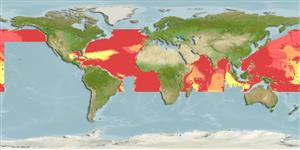Environment: milieu / climate zone / depth range / distribution range
Ecología
marino batipelágico; rango de profundidad 785 - 4580 m (Ref. 58302), usually 1200 - 2000 m (Ref. 32364). Deep-water; 55°N - 20°S, 180°W - 180°E
Circumglobal: In tropical to temperate waters. North of about 20°S; except Mediterranean Sea and eastern Central Pacific. NorthEast Pacific: Queen Charlotte Islands, British Colombia, Canada to central Mexico, including the Gulf of California (Ref. 32364).
Tamaño / Peso / Age
Maturity: Lm ? range ? - ? cm
Max length : 80.0 cm TL macho / no sexado; (Ref. 96339)
Short description
Morfología | Morfometría
Espinas dorsales (total): 0; Radios blandos dorsales (total): 300; Espinas anales 0. Dorsal fin with up to 350 rays; caudal much reduced, linear; anal fin rays 265-270 or more; pectorals small (Ref. 6885). Uniform dusky brown, except jaws, pectoral fins, and lower abdomen which are paler (Ref. 6885). Strong sexual dimorphism (Ref. 3247).
Meso- and bathypelagic (Ref. 58302). Feed on crustaceans (Ref. 3247). Oviparous, with planktonic leptocephali (Ref. 32364). Degenerative changes in males and females suggest semelparity (Ref. 32364). Minimum depth from Ref. 58018.
Life cycle and mating behavior
Madurez | Reproducción | Puesta | Huevos | Fecundidad | Larva
Smith, D.G., 1990. Nemichthyidae. p. 199-202. In J.C. Quero, J.C. Hureau, C. Karrer, A. Post and L. Saldanha (eds.) Check-list of the fishes of the eastern tropical Atlantic (CLOFETA). JNICT, Lisbon; SEI, Paris; and UNESCO, Paris. Vol. 1. (Ref. 4456)
IUCN Red List Status (Ref. 130435)
Threat to humans
Harmless
Human uses
Pesquerías: sin interés
Más información
Age/SizeCrecimientoLength-weightLength-lengthLength-frequenciesMorfometríaMorfologíaLarvaDinámica larvariaReclutamientoAbundanciaBRUVS
ReferenciasAcuiculturaPerfil de acuiculturaRazasGenéticaElectrophoresesheritabilidadEnfermedadesProcesamientoNutrientsMass conversion
Herramientas
Special reports
Download XML
Fuentes de Internet
Estimates based on models
Preferred temperature (Ref.
123201): 2.2 - 5.6, mean 3.6 °C (based on 1847 cells).
Phylogenetic diversity index (Ref.
82804): PD
50 = 0.5645 [Uniqueness, from 0.5 = low to 2.0 = high].
Bayesian length-weight: a=0.00102 (0.00046 - 0.00225), b=3.06 (2.88 - 3.24), in cm total length, based on all LWR estimates for this body shape (Ref.
93245).
Nivel trófico (Ref.
69278): 3.5 ±0.50 se; based on food items.
Resiliencia (Ref.
120179): Bajo, población duplicada en un tiempo mínimo de 4.5-14 años (Assuming tmax>10).
Fishing Vulnerability (Ref.
59153): Moderate to high vulnerability (52 of 100).
